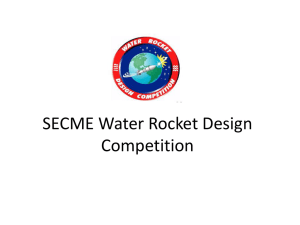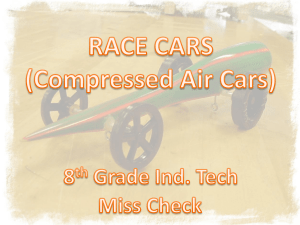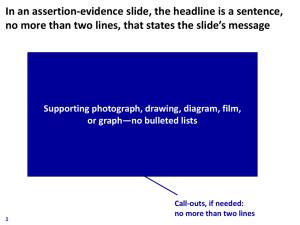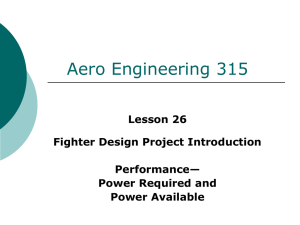Rocket Performance
advertisement
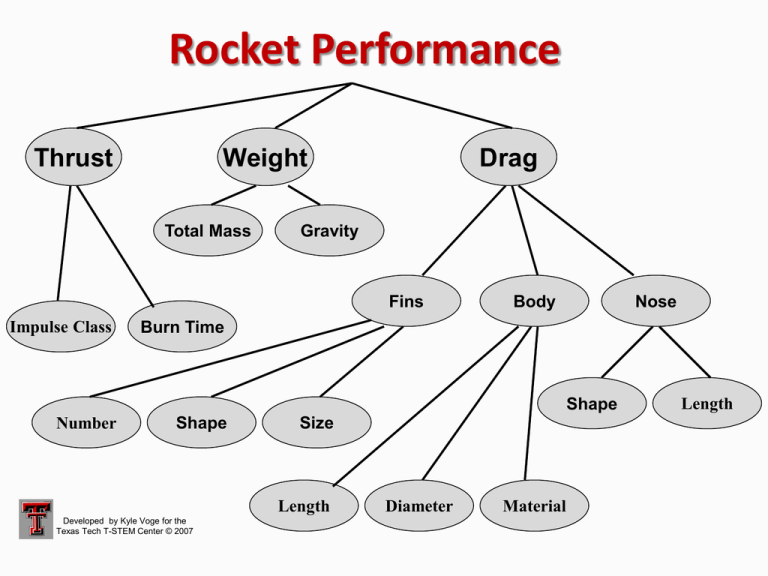
Rocket Performance Thrust Weight Total Mass Drag Gravity Fins Impulse Class Body Nose Burn Time Shape Number Shape Size Length Developed by Kyle Voge for the Texas Tech T-STEM Center © 2007 Diameter Material Length Thrust Impulse Class I F dt Burn Time • “Thrust” refers to the force that a motor produces during flight • For simpler but less accurate simulations, assume constant thrust • For more complicated but more accurate simulations, determine force profile, I.e. force as a function of time F(t) • The thrust given by a specific motor depends on the impulse class of the motor and the amount of time it burns• You could have a motor burn: • Relatively weakly for a longer time • Relatively strongly for a shorter time • THIS MAKES A BIG DIFFERENCE! HOME Impulse Class •Motors are classified by impulse- though not technically accurate, you could think of this as the amount of power a motor can generate. •Impulse = force x time •Think of this as “man-hours” on a job •J motors put out between 640 and 1280 N*s of impulse •That’s: •640 Newtons for 1 second or •1 Newton for 640 seconds or •Some combination thereof UP Burn Time HOME Burn Time • The amount of impulse a motor generates is indicated by the letter- but the letter alone tells you nothing about how long the motor will fire. • The motor manufacturer will provide data on the specifications of each motor. For example- HyperTek makes a J331 motor. •The burn time is 3.2 seconds •The “331” refers to average thrust (in Newtons) •Therefore the total impulse = 331N*3.2s = 1059.2N*s •(This is between 6640 and 1280, so that’s why it’s a “J” motor) • This is for THAT SPECIFIC MOTOR- each “J” is going to be different. • The one you want depends on many factors- average thrust, diameter, burn time, and perhaps most importantly, price. UP Impulse Class HOME Weight Total Mass Gravity • The weight of a rocket is one of three principle forces acting during flight • Newton’s 2nd Law says F = ma…. In this case, Weight = Mass times Gravity • Of course, the total mass of the rocket and the acceleration of gravity both change during flight- you’ll have to decide how accurate you want your simulation to be. HOME Total Mass • The total mass of the rocket is just that- all components of the airframe, recovery, payload, and perhaps the most overlooked component of mass: the motor and propellant. • It is difficult to accurately predict the mass of a planned rocket because the exact amount of glue and epoxy you will use isn’t known. • Perhaps a good strategy would be to slightly overestimate your mass in your simulations- you could always add some modeling clay or silly putty later. • Intuitively one might think that you’d want your rocket to be as light as possible to maximize altitude. • This is correct during powered flight… but not during the “coast” phase of flight. UP Gravity HOME Gravity • Near the surface of the Earth, the acceleration of gravity is 9.81 m/s/s. • As you increase altitude, the acceleration of gravity decreases: Gm1m2 Fg r2 • The effect of this is quite small for low to moderate altitudes- even at 100 miles above the surface, the acceleration has dropped less than 5% to 9.38 m/s/s • This is probably going to be the least significant effect to model in the simulationin other words, it probably won’t make much of a difference. • Again, it all depends on how accurate you want your simulation to be. UP Total Mass HOME Drag Fins Body Nose • Arguably the most significant effect on a rocket’s performance, aerodynamic drag is a non-conservative force that always acts to oppose the rocket’s motion. • The general equation for drag depends on area, velocity, fluid density, and the coefficient of drag: 1 Fd AV 2C D 2 • Practical considerations: • As velocity increases, drag forces increase • As the surface area of a rocket increases, drag increases • As the density of air decreases, drag decreases HOME Fins Number Shape Size • Fins increase the surface area of the rocket, and when placed near the rear end, can help improve stability by moving the CP back. UP Body Nose HOME Number • More fins = more stability, but also means more mass and more drag • Another factor to consider is ease of construction- many people have chosen 4 fins over 3 because 90 degree angles are easier to construct than 120 degree angles. UP Shape Size HOME Shape • Fin shape plays an important role in both drag and stability. • Fin shapes help determine the CP• “Forward-swept” fins won’t move the CP back as far as “Back-swept” shapes UP Number Size HOME Size • Bigger fins = more stability, but also means more mass and more drag UP Number Shape HOME Body Length Diameter Material • Body here refers to the tube- not including the nose nor fins. • Body tube design plays a significant role in both determining stability and in drag forces. UP Fins Nose HOME Length •The length of the body tube plays a role in CP and CM • A longer body can mean more stability, but… • It also means more drag and more mass. UP Diameter Material HOME Diameter • The diameter of the body tube GREATLY affects drag. • A bigger diameter will mean more drag… and because the drag force is proportional to the AREA of the rocket (which is proportional to the radius squared)…. • Doubling the diameter doesn’t double the drag force- it QUADRUPLES it. •Of course, diameter will be determined by payload- your tube needs to be big enough to carry what you want. UP Length Material HOME Material • The material the body tube is made of has significant effects on mass and cost, but only minor effects on drag. • You need to choose a material that will be strong enough to resist the forces it will encounter during flight. •Usually, stronger materials are heavier, so there is a trade-off between strength and mass. • Whichever material you choose, it is important to sand and finish it smooth to minimize drag effects. UP Length Diameter HOME Nose Shape Length • The nose cone design plays arguably the biggest role in drag effects. • The main purpose of a nosecone is to decrease the pressure-induced drag of the rocket as it moves through the air. UP Fins Body HOME Shape • There are several common nosecone shapes available: •Ogive •Parabolic •Conical • Each of these shapes has distinct advantages and disadvantages. • Select the shape based on your goals- breaking Mach, maximizing altitude, etc. UP Length HOME Length • Von Karman’s equations show that maximum efficiency occurs when the length of the nosecone approaches infinity. • Of course, there are trade-offs here, too: • A longer nose will: • Decrease pressure-induced drag • Increase mass • Decrease stability by moving the CP forward UP Shape HOME

